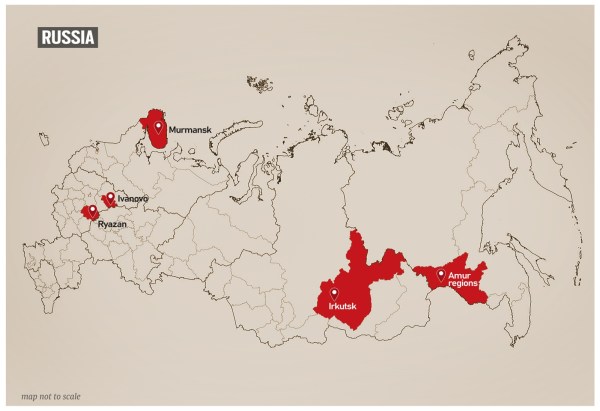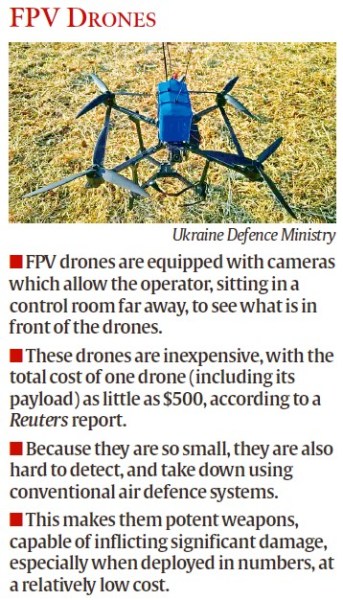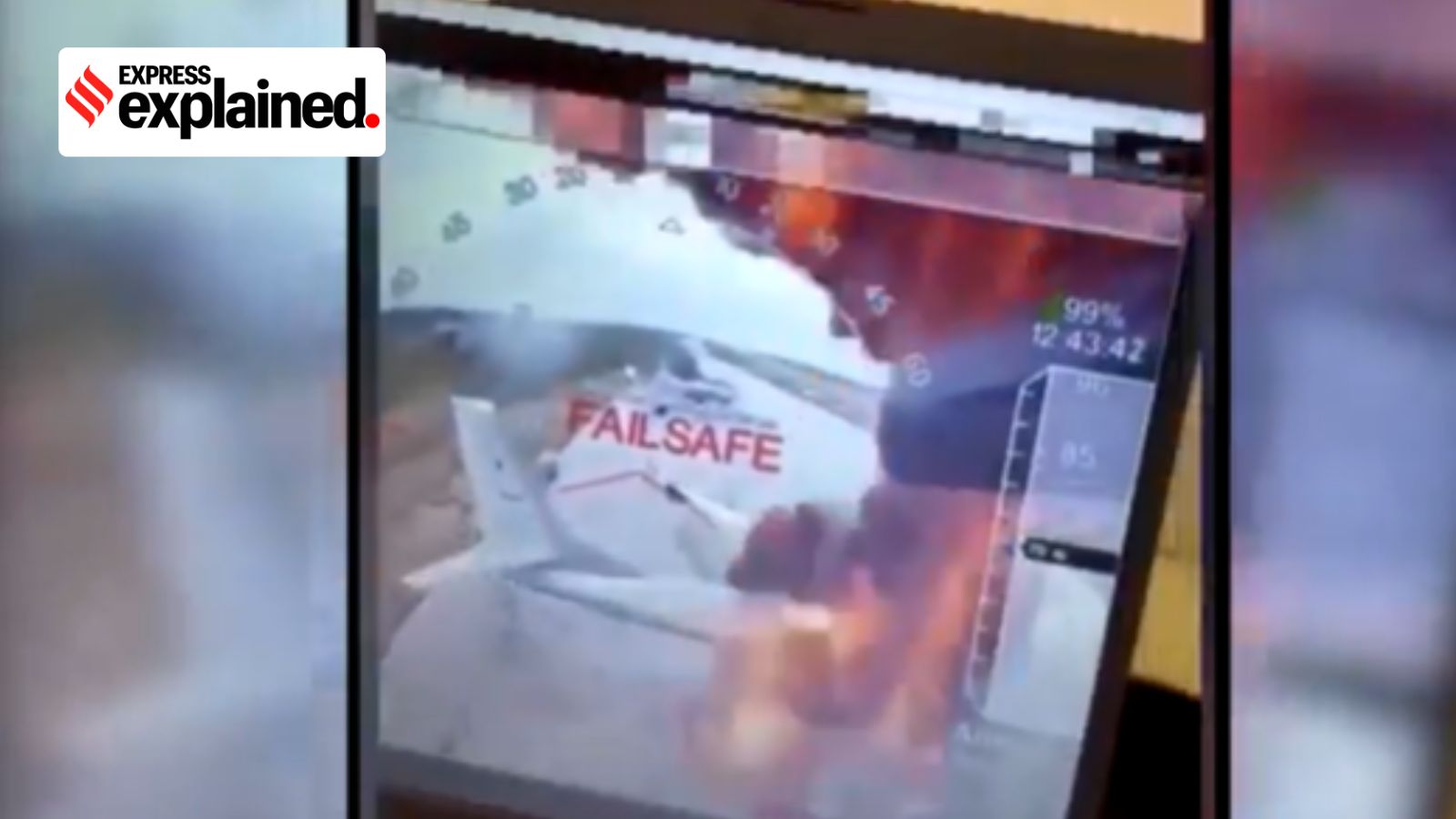Under Operation Spider Web, a swarm of Ukrainian drones struck at least five military airbases deep inside Russia’s borders on June 1, and left some 41 bomber aircraft in flames.
Ukraine President Volodymyr Zelenskyy celebrated the “absolutely brilliant result”, and said the Ukrainian actions will “undoubtedly be in the history books”. He said planning began 18 months ago, and those involved “were withdrawn from Russian territory in time”.
Story continues below this ad
The attack came after Russia stepped up the bombing of Ukrainian cities, and was timed ahead of the second round of crucial talks between the two sides in Istanbul, Turkey. The talks, which began on Monday afternoon, concluded after two hours, with no information on their outcome.
Trojan Horse attack
Specialised first-person view (FPV) drones were smuggled into Russia, along with mobile wooden cabins. The cabins were carried by trucks with the drones hidden inside. The cabin roofs opened remotely — and then the drones took off, zoned in on the nearby bases to precisely mount the attacks.
Ukraine claimed the attack caused $7 billion in damage, and multiple combat planes were destroyed. The Russian defence ministry said Ukraine launched FPV drone attacks on five air bases across the Murmansk, Irkutsk, Ivanovo, Ryazan, and Amur regions. It said that all strikes on the Ivanovo, Ryazan, and Amur airfields were successfully repelled.
 The Russian defence ministry said Ukraine launched FPV drone attacks on five airbases across the Murmansk, Irkutsk, Ivanovo, Ryazan, and Amur regions. What is significant is that small drones were used to strike deep into Russian territory. (Express)
The Russian defence ministry said Ukraine launched FPV drone attacks on five airbases across the Murmansk, Irkutsk, Ivanovo, Ryazan, and Amur regions. What is significant is that small drones were used to strike deep into Russian territory. (Express)
Audacity of the mission
“(For) all the long range missiles and fighter jets, but it was 150 drones in shipping containers or trucks that took out a reported third of Russia’s strategic bomber fleet and unmanned surface drones that neutered the Black Fleet,” said Alex Plitsas, a nonresident senior fellow with the Middle East Program’s Scowcroft Middle East Security Initiative, and formerly associated with Bridgewater Associates and NorthropGrumman.
Story continues below this ad
“Warfare as we knew it just a decade ago, is over,” he said. There are several reasons why the attack changes the rules of battlefield engagement in Ukraine:
This was one of the significant raiding actions in modern warfare, one which was planned for 18 months.

It was different from the sort of attacks Ukraine has mounted so far — larger fixed-wing drones attacking at night, closer to the Russia-Ukraine border. The June 1 attack upends that pattern entirely: small drones were used during the day, far away from the frontlines. In Irkutsk province in eastern Siberia, thousands of kilometres from Ukraine, locals posted footage of small quadcopter drones emerging from the roof of trucks, and flying towards a nearby airfield, followed by smoke after impact.
Among the 41 aircraft said to have been destroyed are A-50 early-warning planes and Tu-22M3 and Tu-95 strategic bombers, most of which are now out of production, and extremely difficult to replace.
Story continues below this ad
Russia is estimated to have had fewer than 100 strategic bombers, and around a third of that fleet has been impacted by the attack.
These attacks were carried out by the SBU, Ukraine’s main security agency. The agency released footage in which its chief, Vasily Maliuk, said: “Russian strategic bombers… all burning delightfully.”

Commentators on X aligned to Ukraine’s security services indicated that over a 100 quadcopter FPV drones with bombs were smuggled into Russia for the operations, which were meticulously housed in specially-built wooden cabins on top of lorries, with remotely retractable roofs.
FPV drones are smaller in size and have cameras on their front, which sends live video to the operator. This enables precise flying and manoeuvrability by the operator, almost like an aircraft. The Economist reported that these drones used Russian mobile-telephone networks to relay footage back to Ukraine.
It is possible that the drivers of the trucks did not know their cargo.
Story continues below this ad
A source quoted by The Economist said the Russians were first encouraged to move more of their planes to particular bases by Ukrainian strikes on other ones. Three days before this drone attack, dozens of planes were moved to the Olenya airfield in Murmansk province, according to reports published at the time. This was precisely where the most damage was caused.
The Ukrainian strikes demonstrate the effectiveness of deep-strike programs, and take the possibilities of drone warfare to another level.
According to Thomas Shugart, an Adjunct Senior Fellow with the Defense Program at the Center for New American Security who served for more than 25 years in the US Navy, “containers at railyards, on Chinese-owned container ships in port or offshore, on trucks parked at random properties… spewing forth thousands of drones that sally forth and at least mission-kill the crown jewels of the [US Air Force]”… would be “entirely feasible”.
The warning issued by Shugart, who has previously written about the threat to airfields from drones and recommended that key aircraft such as bombers should have hardened shelters for just this sort of attack, could resonate across geographies, including in India.


